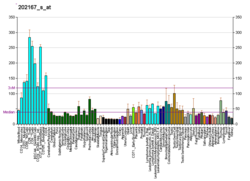| MMS19 |
|---|
|
| Identifiers |
|---|
| Aliases | MMS19, MET18, MMS19L, hMMS19 homolog, cytosolic iron-sulfur assembly component, CIAO4 |
|---|
| External IDs | OMIM: 614777; MGI: 1919449; HomoloGene: 41480; GeneCards: MMS19; OMA:MMS19 - orthologs |
|---|
| Gene location (Human) |
|---|
 | | Chr. | Chromosome 10 (human)[1] |
|---|
| | Band | 10q24.1 | Start | 97,458,324 bp[1] |
|---|
| End | 97,498,794 bp[1] |
|---|
|
| Gene location (Mouse) |
|---|
 | | Chr. | Chromosome 19 (mouse)[2] |
|---|
| | Band | 19|19 C3 | Start | 41,929,525 bp[2] |
|---|
| End | 41,969,596 bp[2] |
|---|
|
| RNA expression pattern |
|---|
| Bgee | | Human | Mouse (ortholog) |
|---|
| Top expressed in | - right hemisphere of cerebellum
- anterior pituitary
- skin of leg
- right testis
- skin of abdomen
- left testis
- tibial nerve
- apex of heart
- right ovary
- ventricular zone
|
| | Top expressed in | - tail of embryo
- neural layer of retina
- genital tubercle
- muscle of thigh
- granulocyte
- ventricular zone
- superior frontal gyrus
- thymus
- lip
- oocyte
|
| | More reference expression data |
|
|---|
| BioGPS |  | | More reference expression data |
|
|---|
|
| Gene ontology |
|---|
| Molecular function | - protein-macromolecule adaptor activity
- transcription coactivator activity
- protein binding
- enzyme binding
- signaling receptor complex adaptor activity
- estrogen receptor binding
| | Cellular component | - membrane
- nucleoplasm
- transcription factor TFIIH holo complex
- CIA complex
- cytoskeleton
- MMXD complex
- nucleus
- cytoplasm
- spindle
- cytosol
| | Biological process | - regulation of transcription, DNA-templated
- chromosome segregation
- DNA metabolic process
- cellular response to DNA damage stimulus
- positive regulation of transcription, DNA-templated
- iron-sulfur cluster assembly
- phosphorelay signal transduction system
- response to hormone
- DNA repair
- nucleotide-excision repair
- transcription, DNA-templated
- protein maturation by iron-sulfur cluster transfer
- positive regulation of double-strand break repair via homologous recombination
- positive regulation of signal transduction
| | Sources:Amigo / QuickGO |
|
| Orthologs |
|---|
| Species | Human | Mouse |
|---|
| Entrez | | |
|---|
| Ensembl | | |
|---|
| UniProt | | |
|---|
| RefSeq (mRNA) | NM_001289403
NM_001289404
NM_001289405
NM_022362
NM_001330128
|
|---|
NM_001351356
NM_001351357
NM_001351358
NM_001351359 |
| |
|---|
| RefSeq (protein) | NP_001276332
NP_001276333
NP_001276334
NP_001317057
NP_071757
|
|---|
NP_001338285
NP_001338286
NP_001338287
NP_001338288 |
| |
|---|
| Location (UCSC) | Chr 10: 97.46 – 97.5 Mb | Chr 19: 41.93 – 41.97 Mb |
|---|
| PubMed search | [3] | [4] |
|---|
|
| Wikidata |
| View/Edit Human | View/Edit Mouse |
|
















